User:DefenseSupportParty/USAF
The United States Air Force (USAF) is the aerial warfare branch of the U.S. armed forces and one of the seven American uniformed services. It was first called the United States Army Air Corps, because it was part of the United States Army. The USAF was made a branch of the military on September 18, 1947.[1] It was the last branch of the U.S. military to be made.
The USAF is the largest air force in the world, with 5,778 aircraft, (4,093 USAF; 1,289 Air National Guard; and 396 Air Force Reserve);[2] 156 unmanned combat air vehicles, 2,130 cruise missiles,[3] and 450 intercontinental ballistic missiles. The USAF has 328,439 airmen on active duty, 74,000 in the Selected and Individual Ready Reserves, and 106,000 in the Air National Guard. They also have 168,900 civilians working for them, including some foreign nationals.[4]
The Department of the Air Force is headed by the civilian Secretary of the Air Force who heads administrative affairs. The Department of the Air Force is a part of the Department of Defense. The highest ranking military officer in the Department of the Air Force is the Chief of Staff of the Air Force.
Mission[change | change source]
1. According to the National Security Act of 1947 which made the Air Force:
In general the United States Air Force shall include aviation forces both combat and service not otherwise assigned. It shall be organized, trained, and equipped primarily for prompt and sustained offensive and defensive air operations. The Air Force shall be responsible for the preparation of the air forces necessary for the effective prosecution of war except as otherwise assigned and, in accordance with integrated joint mobilization plans, for the expansion of the peacetime components of the Air Force to meet the needs of war.
2. §8062 of Title 10 US Code (10 USC 8062) defines the purpose of the Air Force as:
- to preserve the peace and security, and provide for the defense, of the United States, the Territories, Commonwealths, and possessions, and any areas occupied by the United States;
- to support national policy;
- to implement national objectives;
- to overcome any nations responsible for aggressive acts that imperil the peace and security of the United States.
3. The stated mission of the USAF today is to "fly, fight, and win in air, space, and cyberspace".[5]
History[change | change source]
The United States Air Force became a separate military service on September 18, 1947, with the implementation of the National Security Act of 1947.[6] The Act created the United States Department of Defense, which was composed of three branches, the Army, Navy and a newly-created Air Force.[7] Prior to 1947, the responsibility for military aviation was divided between the Army (for land-based operations) and the Navy, for sea-based operations from aircraft carrier and amphibious aircraft. The Army created the first antecedent of the Air Force in 1907, which through a succession of changes of organization, titles, and missions advanced toward eventual separation 40 years later.
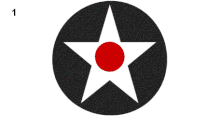
1. 5/17-2/18 2. 2/18-8/19 3. 8/19-5/42
4. 5/42-6/43 5. 6/43-9/43 6. 9/43-1/47
7. 1/47-
The predecessor organizations of today's U.S. Air Force are:
- Aeronautical Division, U.S. Signal Corps (August 1, 1907 to July 18, 1914)
- Aviation Section, U.S. Signal Corps (July 18, 1914 to May 20, 1918)
- Division of Military Aeronautics (May 20, 1918 to May 24, 1918)
- U.S. Army Air Service (May 24, 1918 to July 2, 1926)
- U.S. Army Air Corps (July 2, 1926 to June 20, 1941) and
- U.S. Army Air Forces (June 20, 1941 to September 17, 1947)
Recent history[change | change source]
In 2007, the USAF implemented a large Reduction-in-Force (RIF). Because of budget constraints, the USAF planned to reduce the service's size from 360,000 active duty personnel, to 316,000.[8] The size of the active-duty force in 2007 is roughly 64% of that of the USAF at the end of the Gulf War in 1991.[9] However, the reduction was ended at approximately 330,000 personnel in 2008 to meet mission requirements.[8]
On June 5, 2008, Secretary of Defense Robert M. Gates, accepted the resignations of both the Secretary of the Air Force, Michael W. Wynne, and the Chief of Staff of the United States Air Force, Gen. T. Michael Moseley. Gates in effect fired both men for "systemic issues associated with declining Air Force nuclear mission focus and performance". This followed an investigation into two embarrassing incidents involving nuclear weapons, and were also the culmination of disputes between the Air Force leadership and Gates.[10] To put more emphasis on nuclear assets, the USAF established the nuclear-focused Global Strike Command on October 24, 2008.[11]
Wars[change | change source]

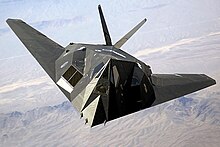
The United States Air Force has been involved in many wars, conflicts, and operations since, and before, its conception; these include:
- World War I[12] Aviation Section, U.S. Signal Corps
- World War II[12] United States Army Air Forces
- Cold War
- Korean War
- Vietnam War
- Operation Eagle Claw (Iranian Hostage Rescue)
- Operation Urgent Fury (US Invasion of Grenada)
- Operation Eldorado Canyon (US Bombing of Libya)
- Operation Just Cause (US Invasion of Panama)
- Operation Desert Shield and Operation Desert Storm (Gulf War)
- Operation Northern Watch (Iraq No-Fly Zone)
- Operation Southern Watch (Iraq No-Fly Zone)
- Operation Deliberate Force (1995 NATO bombing in Bosnia and Herzegovina)
- Operation Allied Force (1999 NATO bombing of Yugoslavia)
- Operation Enduring Freedom (Afghanistan War)
- Operation Iraqi Freedom (Iraq War)
Humanitarian operations[change | change source]
The U.S. Air Force has taken part in numerous humanitarian operations. Some of the more major ones include the following:[13]
- Berlin Airlift (Operation Vittles), 1948-1949
- Operation Safe Haven, 1956-1957
- Operations Babylift, New Life, Frequent Wind, and New Arrivals, 1975
- Operation Provide Comfort, 1991
- Operation Sea Angel, 1991
- Operation Provide Hope, 1992-1993
- Operation Unified Assistance, December 2004 - April 2005
Organization[change | change source]
Administrative organization[change | change source]
The Air Force is one of three service departments, and is managed by the (civilian) Department of the Air Force. Guidance is provided by the Secretary of the Air Force (SECAF) and the Secretary's staff and advisors. The military leadership is the Air Staff, led by the Chief of Staff.
USAF direct subordinate commands and units are the Field Operating Agency (FOA), Direct Reporting Unit (DRU), and the currently unused Separate Operating Agency.
The Major Command (MAJCOM) is the superior hierarchical level of command. Including the Air Force Reserve Command, as of September 30, 2006, USAF has nine major commands, and a tenth, Air Force Cyber Command, in process. The Numbered Air Force (NAF) is a level of command directly under the MAJCOM, followed by Operational Command (now unused), Air Division (also now unused), Wing, Group, Squadron, and Flight.
Force structure[change | change source]
![]() Headquarters, United States Air Force, The Pentagon, Arlington, Virginia
Headquarters, United States Air Force, The Pentagon, Arlington, Virginia
 Air Combat Command (ACC), headquartered at Langley Air Force Base, Virginia
Air Combat Command (ACC), headquartered at Langley Air Force Base, Virginia
 First Air Force, headquartered at Tyndall Air Force Base, Florida
First Air Force, headquartered at Tyndall Air Force Base, Florida Ninth Air Force, headquartered at Shaw Air Force Base, South Carolina
Ninth Air Force, headquartered at Shaw Air Force Base, South Carolina Twelfth Air Force, headquartered at Davis-Monthan Air Force Base, Arizona
Twelfth Air Force, headquartered at Davis-Monthan Air Force Base, Arizona United States Air Force Warfare Center, headquartered at Nellis Air Force Base, Nevada
United States Air Force Warfare Center, headquartered at Nellis Air Force Base, Nevada
 Air Education and Training Command (AETC), headquartered at Randolph Air Force Base, Texas
Air Education and Training Command (AETC), headquartered at Randolph Air Force Base, Texas
 Second Air Force, headquartered at Keesler Air Force Base, Mississippi
Second Air Force, headquartered at Keesler Air Force Base, Mississippi Nineteenth Air Force, headquartered at Randolph Air Force Base, Texas
Nineteenth Air Force, headquartered at Randolph Air Force Base, Texas Air Force Recruiting Service, headquartered at Randolph Air Force Base, Texas
Air Force Recruiting Service, headquartered at Randolph Air Force Base, Texas Air University, headquartered at Maxwell-Gunter Air Force Base, Alabama
Air University, headquartered at Maxwell-Gunter Air Force Base, Alabama- Wilford Hall Medical Center, headquarted at Lackland Air Force Base, Texas
- Air Force Global Strike Command (GSC), interim headquarters at Bolling Air Force Base, District of Columbia
 Eighth Air Force, headquartered at Barksdale Air Force Base, Louisiana
Eighth Air Force, headquartered at Barksdale Air Force Base, Louisiana Twentieth Air Force, headquartered at F. E. Warren Air Force Base, Wyoming
Twentieth Air Force, headquartered at F. E. Warren Air Force Base, Wyoming
 Air Force Materiel Command (AFMC), headquartered at Wright-Patterson Air Force Base, Ohio
Air Force Materiel Command (AFMC), headquartered at Wright-Patterson Air Force Base, Ohio
- Aeronautical Systems Center, headquartered at Wright-Patterson Air Force Base, Ohio
 Air Force Flight Test Center, headquartered at Edwards Air Force Base, California
Air Force Flight Test Center, headquartered at Edwards Air Force Base, California Air Force Global Logistics Support Center, headquartered at Scott Air Force Base, Illinois
Air Force Global Logistics Support Center, headquartered at Scott Air Force Base, Illinois Air Force Nuclear Weapons Center, headquartered at Kirtland Air Force Base, New Mexico
Air Force Nuclear Weapons Center, headquartered at Kirtland Air Force Base, New Mexico Air Force Research Laboratory, headquartered at Wright-Patterson Air Force Base, Ohio
Air Force Research Laboratory, headquartered at Wright-Patterson Air Force Base, Ohio Air Force Security Assistance Center, headquartered at Wright-Patterson Air Force Base, Ohio
Air Force Security Assistance Center, headquartered at Wright-Patterson Air Force Base, Ohio Air Armament Center, headquartered at Eglin Air Force Base, Florida
Air Armament Center, headquartered at Eglin Air Force Base, Florida Arnold Engineering Development Center, headquartered at Arnold Air Force Base, Tennessee
Arnold Engineering Development Center, headquartered at Arnold Air Force Base, Tennessee Electronic Systems Center, headquartered at Hanscom Air Force Base, Massachusetts
Electronic Systems Center, headquartered at Hanscom Air Force Base, Massachusetts
 Air Force Reserve Command (AFRC), headquartered at Robins Air Force Base, Georgia
Air Force Reserve Command (AFRC), headquartered at Robins Air Force Base, Georgia
 Fourth Air Force, headquartered at March Air Reserve Base, California
Fourth Air Force, headquartered at March Air Reserve Base, California Tenth Air Force, headquartered at Naval Air Station Joint Reserve Base Fort Worth, Texas
Tenth Air Force, headquartered at Naval Air Station Joint Reserve Base Fort Worth, Texas Twenty-Second Air Force, headquartered at Dobbins Air Reserve Base, Georgia
Twenty-Second Air Force, headquartered at Dobbins Air Reserve Base, Georgia- Air Reserve Personnel Center, headquartered at Denver, Colorado
 Air Force Space Command (AFSPC), headquartered at Peterson Air Force Base, Colorado
Air Force Space Command (AFSPC), headquartered at Peterson Air Force Base, Colorado
 Fourteenth Air Force, headquartered at Vandenberg Air Force Base, California
Fourteenth Air Force, headquartered at Vandenberg Air Force Base, California Twenty Fourth Air Force, interim headquarters at Barksdale Air Force Base, Louisiana
Twenty Fourth Air Force, interim headquarters at Barksdale Air Force Base, Louisiana Space and Missile Systems Center, headquartered at Los Angeles Air Force Base, California
Space and Missile Systems Center, headquartered at Los Angeles Air Force Base, California Space Innovation and Development Center, headquartered at Schriever Air Force Base, Colorado
Space Innovation and Development Center, headquartered at Schriever Air Force Base, Colorado

 Air Force Special Operations Command (AFSOC), headquartered at Hurlburt Field, Florida
Air Force Special Operations Command (AFSOC), headquartered at Hurlburt Field, Florida
 Twenty-Third Air Force, headquartered at Hurlburt Field, Florida
Twenty-Third Air Force, headquartered at Hurlburt Field, Florida- Special Operations Training Center, headquartered at Hurlburt Field, Florida
 Air Mobility Command (AMC), headquartered at Scott Air Force Base, Illinois
Air Mobility Command (AMC), headquartered at Scott Air Force Base, Illinois
 Eighteenth Air Force, headquartered at Scott Air Force Base, Illinois
Eighteenth Air Force, headquartered at Scott Air Force Base, Illinois United States Air Force Expeditionary Center, headquartered at Fort Dix, New Jersey
United States Air Force Expeditionary Center, headquartered at Fort Dix, New Jersey
 United States Air Forces in Europe (USAFE), headquartered at Ramstein Air Base, Germany
United States Air Forces in Europe (USAFE), headquartered at Ramstein Air Base, Germany
 Third Air Force, headquartered at Ramstein Air Base, Germany
Third Air Force, headquartered at Ramstein Air Base, Germany Seventeenth Air Force, headquartered at Sembach Annex, Germany
Seventeenth Air Force, headquartered at Sembach Annex, Germany
 Pacific Air Forces (PACAF), headquartered at Hickam Air Force Base, Hawaii
Pacific Air Forces (PACAF), headquartered at Hickam Air Force Base, Hawaii
 Fifth Air Force, headquartered at Yokota Air Base, Japan
Fifth Air Force, headquartered at Yokota Air Base, Japan Seventh Air Force, headquartered at Osan Air Base, Republic of Korea
Seventh Air Force, headquartered at Osan Air Base, Republic of Korea Eleventh Air Force, headquartered at Elmendorf Air Force Base, Alaska
Eleventh Air Force, headquartered at Elmendorf Air Force Base, Alaska Thirteenth Air Force, headquartered at Hickam Air Force Base, Hawaii
Thirteenth Air Force, headquartered at Hickam Air Force Base, Hawaii
The permanent establishment of the USAF, as of September 30, 2006,[14] consisted of:
- Active duty forces:
- 57 flying wings, 8 space wings, and 55 non-flying wings
- 9 flying groups, 8 non-flying groups
- 134 flying squadrons, 43 space squadrons
- Air Force Reserve
- 35 flying wings, 1 space wing
- 4 flying groups
- 67 flying squadrons, 6 space squadrons
- Air National Guard
- 87 flying wings
- 101 flying squadrons, 4 space squadrons
- 87 flying wings
The United States Air Force and its Air Reserve Components field a total of 302 flying squadrons.[15]
Operational organization[change | change source]
The above organizational structure is responsible for the peacetime Organization, Equipping, and Training of aerospace units for operational missions. When required to support operational missions, the National Command Authority directs a Change in Operational Control (CHOP) of these units from their peacetime alignment to a Regional Combatant Commander (CCDR). In the case of AFSPC, AFSOC, PACAF, and USAFE units, forces are normally employed in-place under their existing CCDR. Likewise, AMC forces operating in support roles retain their componency to USTRANSCOM unless chopped to a Regional CCDR.
Aerospace Expeditionary Task Force[change | change source]
CHOPPED units are referred to as "forces". The top-level structure of these forces is the Air and Space Expeditionary Task Force (AETF). The AETF is the Air Force presentation of forces to a CCDR for the employment of Air Power. Each CCDR is supported by a standing Component Numbered Air Force (C-NAF) to provide planning and execution of aerospace forces in support of CCDR requirements. Each C-NAF consists of a Commander, Air Force Forces (COMAFFOR) and AFFOR/A-staff, and an Air Operations Center (AOC). As needed to support multiple Joint Force Commanders (JFC) in the COCOM's Area of Responsibility (AOR), the C-NAF may deploy Air Component Coordinate Elements (ACCE) to liaise with the JFC. If the Air Force possesses the most strategic air assets in a JFC's area of operations, the COMAFFOR will also serve as the Joint Forces Air Component Commander (JFACC).
Commander, Air Force Forces[change | change source]
The Commander, Air Force Forces (COMAFFOR) is the senior Air Force officer responsible for the employment of Air Power in support of JFC objectives. The COMAFFOR has a special staff and an A-Staff to ensure assigned or attached forces are properly organized, equipped, and trained to support the operational mission.
Air Operations Center[change | change source]
The Air Operations Center (AOC) is the JFACC's Command and Control (C²) center. This center is responsible for planning and executing air power missions in support of JFC objectives.
Air Expeditionary Wings/Groups/Squadrons[change | change source]
The AETF generates air power to support COCOM objectives from Air Expeditionary Wings (AEW) or Air Expeditionary Groups (AEG). These units are responsible for receiving combat forces from Air Force MAJCOMs, preparing these forces for operational missions, launching and recovering these forces, and eventually returning forces to the MAJCOMs. Theater Air Control Systems control employment of forces during these missions.
Personnel[change | change source]
The vast majority of Air Force members remain on the ground. There are hundreds of support positions which are necessary to the success of a mission.
The classification of an Air Force job is the Air Force Specialty Code (AFSC). They range from flight combat operations such as a gunner, to working in a dining facility to ensure that members are properly fed. There are many different jobs in fields such as computer specialties, mechanic specialties, enlisted aircrew, medical specialties, civil engineering, public affairs, hospitality, law, drug counseling, mail operations, security forces, and search and rescue specialties.[16]
Perhaps the most dangerous Air Force jobs are Explosive Ordnance Disposal (EOD), Combat rescue officer, Pararescue, Security Forces, Combat Control, Combat Weather and Tactical Air Control Party, who deploy with infantry and special operations units who disarm bombs, rescue downed or isolated personnel, call in air strikes and set up landing zones in forward locations. Most of these are enlisted positions. Other jobs have seen increasing combat, including engineers, vehicle operators, and OSI.
Nearly all enlisted jobs are "entry level," meaning that the Air Force provides all training. Some enlistees are able to choose a particular job, or at least a field before actually joining, while others are assigned an AFSC at Basic Military Training (BMT). After BMT, new Air Force members attend a technical training school where they learn their particular AFSC. Second Air Force, a part of Air Education and Training Command, is responsible for nearly all technical training.
Training programs vary in length; for example, 3M0X1 (Services) has 31 days of tech school training, while 3E8X1 (Explosive Ordnance Disposal) is 1 year of training with a preliminary school and a main school consisting of over 10 separate divisions, sometimes taking students close to 2 years to complete. Some AFSCs have even shorter or longer training.
USAF rank is divided between enlisted airmen, non-commissioned officers, and commissioned officers, and ranges from "airman basic" to the commissioned rank of general. Promotions are granted based on a combination of test scores, years of experience, and selection board approval. Promotions among enlisted men and non-commissioned officers rankings are generally designated by increasing numbers of insignia chevrons. Commissioned officer rank is designated by bars, oak leaves, a silver eagle, and anywhere from one to five (only in war-time) stars.
Commissioned officers[change | change source]
The commissioned officer ranks of the Air Force are divided into three sections: company grade, field grade, and general officers. Company grade officers are those officers of grades O-1 to O-3. Field grade officers are those of grades O-4 to O-6. General officers are those of O-7 and above.
Currently, promotion from Second Lieutenant to First Lieutenant is virtually guaranteed after two years of satisfactory service. The promotion from First Lieutenant to Captain is competitive after successfully completing another two years of service. Promotion to Major and above is through a board process. An officer's record is reviewed by a selection board at the Air Force Personnel Center at Randolph Air Force Base in San Antonio, Texas. This process occurs approximately between the nine- and eleven-year mark, where a certain percentage of Captains will be selected for Major. This process will repeat at the 13-16 year mark for promotion to Lieutenant Colonel and then around the twenty-year mark for promotion to Colonel.
| Pay grade | Special ¹ | O-10 | O-9 | O-8 | O-7 | O-6 | O-5 | O-4 | O-3 | O-2 | O-1 |
|---|---|---|---|---|---|---|---|---|---|---|---|
| Insignia | 
|

|

|

|
|||||||
| Title | General of the Air Force | General | Lieutenant General | Major General | Brigadier General | Colonel | Lieutenant Colonel | Major | Captain | First Lieutenant | Second Lieutenant |
| Abbreviation | GOAF | Gen | Lt Gen | Maj Gen | Brig Gen | Col | Lt Col | Maj | Capt | 1st Lt | 2d Lt |
|
No periods are used in actual grade abbreviation, only in press releases to conform with AP standards. | |||||||||||
| NATO Code | OF-10 | OF-9 | OF-8 | OF-7 | OF-6 | OF-5 | OF-4 | OF-3 | OF-2 | OF-1 | |
| |||||||||||
Enlisted airmen[change | change source]
Enlisted members of the Air Force have pay grades from E-1 to E-9, with E-9 being the highest. While all Air Force military personnel are referred to as Airmen, it can specifically refer to the pay grades of E-1 through E-4 which are below the level of non-commissioned officers (NCOs). Above the pay grade of E-4 (E-5 through E-9) all ranks fall into the category of NCO and are further subdivided into NCOs (E-5 & E-6) and Senior NCOs (E-7 through E-9); the term Junior NCO is sometimes used to refer to staff sergeants and technical sergeants (E-5 & E-6).
The Air Force is the only one of the five branches of the United States military where NCO status is only achieved at the grade of E-5. In all other branches NCO status can be achieved at the grade of E-4 (a Corporal in the Army and Marine Corps, Petty Officer Third Class in the Navy and Coast Guard). However, E-4s in the Army with the rank of Specialist are not NCOs. The Air Force mirrored the Army from 1976 to 1991 with an E-4 being either a Senior Airman wearing three stripes without a star or a Sergeant (referred to as "Buck Sergeant") which was noted by the presence of the central star and considered an NCO. Despite not being an NCO, a Senior Airman who has completed Airman Leadership School can be a supervisor.
| Pay grade | E-9 | E-8 | E-7 | E-6 | E-5 | E-4 | E-3 | E-2 | E-1 | |||||
|---|---|---|---|---|---|---|---|---|---|---|---|---|---|---|
| Insignia | 
|

|

|

|

|

|

|

|
No Insignia | |||||
| Title | Chief Master Sergeant of the Air Force | Command Chief Master Sergeant | Chief Master Sergeant¹ | Senior Master Sergeant¹ | Master Sergeant¹ | Technical Sergeant | Staff Sergeant | Senior Airman | Airman First Class | Airman | Airman Basic | |||
| Abbreviation | CMSAF | CCM | CMSgt | SMSgt | MSgt | TSgt | SSgt | SrA | A1C | Amn | AB | |||
| NATO Code | OR-9 | OR-9 | OR-9 | OR-8 | OR-7 | OR-6 | OR-5 | OR-4 | OR-3 | OR-2 | OR-1 | |||
| ||||||||||||||
Uniforms and appearance[change | change source]
United States Air Force personnel wear uniforms which are distinct from those of the other branches of the United States Armed Forces. The first Air Force dress uniform, in 1947, was dubbed and patented "Uxbridge Blue" after "Uxbridge 1683 Blue", developed at the former Bachman-Uxbridge Worsted Company. [17] The current U.S. Air Force Service Dress Uniform, which was adopted in 1993 and standardized in 1995, consists of a three-button, pocketless coat, similar to that of a men's "sport jacket" (with silver "U.S." pins on the lapels), matching trousers, and either a service cap or flight cap, all in Shade 1620, "Air Force Blue" (a darker purplish-blue). This is worn with a light blue shirt (Shade 1550) and Shade 1620 herringbone patterned necktie. Enlisted members wear sleeve insignia on both the jacket and shirt, while officers wear metal rank insignia pinned onto the coat, and Air Force Blue slide-on epaulet loops on the shirt. Air Force personnel assigned to Base Honor Guard duties wear, for certain occasions, a modified version of the standard service dress uniform, but with silver trim on the sleeves and trousers, with the addition of a ceremonial belt (if necessary), wheel cap with silver trim and Hap Arnold Device, and a silver aiguillete placed on the left should seam and all devices and accouterment.
The current utility uniform is a new uniform called the Airman Battle Uniform (ABU). The previous utility uniform called the Battle Dress Uniform (BDU) is still authorized for wear but is becoming less common. The new uniform, the Airman Battle Uniform (ABU), is scheduled to completely replace the BDU by 1 October 2011 (Fiscal Year 2012).
Awards and badges[change | change source]
In addition to basic uniform clothing, various badges are used by the USAF to indicate a job assignment or qualification-level for a given assignment. Badges can also be used as merit-based or service-based awards. Over time, various badges have been discontinued and are no longer distributed. Authorized badges include the Shields of USAF Fire Protection, and Security Forces
Training[change | change source]
All enlisted Airmen must undergo basic military training (BMT), which takes place at Lackland AFB, Texas. All officers are commissioned through the United States Air Force Academy, Officer Training School or the AFROTC program.
Air Force Fitness Test[change | change source]
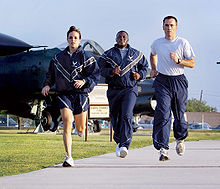
The US Air Force Fitness Test (AFFT) is designed to test the body composition, muscular strength/endurance and cardiovascular respiratory fitness of airmen in the United States Air Force. As part of the Fit to Fight program, the Air Force adopted a more stringent physical fitness assessment; the new fitness program was established on January 1, 2004, and replaces the annual ergo-cycle test that the Air Force had used for several years. In the AFFT, Airmen are given a score based on performance consisting of four components: waist circumference, the crunch, the push-up, and a 1.5-mile (2.4 km) run. Airmen can potentially earn a score of 100; a passing score is anything over 75 points.
Aircraft[change | change source]
The United States Air Force has over 5,778 aircraft commissioned as of 2004. Until 1962, the Army and Air Force maintained one system of aircraft naming, while the U.S. Navy maintained a separate system. In 1962, these were unified into a single system heavily reflecting the Army/Air Force method. For more complete information on the workings of this system, refer to United States Department of Defense aerospace vehicle designation.
Ground Attack[change | change source]
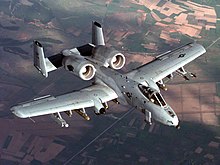
The ground-attack aircraft of the USAF are designed to attack targets on the ground and are often deployed as close air support for, and in proximity to, U.S. ground forces. The proximity to friendly forces require precision strikes from these aircraft that are not possible with bomber aircraft listed above. They are typically deployed as close air support to ground forces, their role is tactical rather than strategic, operating at the front of the battle rather than against targets deeper in the enemy's rear.
Bombers[change | change source]

In the US Air Force, the distinction between bombers, fighter-bombers, and attack aircraft has become blurred. Many attack aircraft, even ones that look like fighters, are optimized to drop bombs, with very little ability to engage in aerial combat. Many fighter aircraft, such as the F-16, are often used as 'bomb trucks,' despite being designed for aerial combat. Perhaps the one meaningful distinction at present is the question of range: a bomber is generally a long-range aircraft capable of striking targets deep within enemy territory, whereas fighter bombers and attack aircraft are limited to 'theater' missions in and around the immediate area of battlefield combat. Even that distinction is muddied by the availability of aerial refueling, which greatly increases the potential radius of combat operations. The US is the only country, besides Russia, that operate strategic bombers.
The majority of the USAF's dedicated bombers are rapidly aging. The B-52 Stratofortress airframe is over 50 years old, and are scheduled to remain in service for another 30 years, which would keep the airframe in service for over 90 years, an unprecedented length of service for any aircraft. Plans for successors to the current strategic bomber force remain only paper projects, and political and funding pressures suggest that they are likely to remain paper-bound for the foreseeable future.
Cargo and Transport[change | change source]
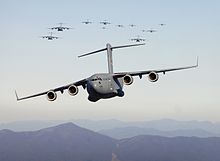
The Air Force can provide rapid global mobility, which lies at the heart of U.S. strategy in this environment--without the capability to project forces, there is no conventional deterrent. As U.S. forces stationed overseas continue to decline, global interests remain, making the unique mobility capabilities of the USAF even more in demand. Air mobility is a national asset of growing importance for responding to emergencies and protecting American interests around the globe.
Cargo and transport aircraft are typically used to deliver troops, weapons and other military equipment by a variety of methods to any area of military operations around the world, usually outside of the commercial flight routes in uncontrolled airspace. The workhorses of the USAF Air Mobility Command are the C-130 Hercules, C-17 Globemaster III, and C-5 Galaxy. These aircraft are largely defined in terms of their range capability as strategic airlift (C-5), strategic/tactical (C-17), and tactical (C-130) airlift to reflect the needs of the land forces which they most often support.
- C-5A/B/C/M Galaxy
- C-12C/D/F Huron
- C-17A Globemaster III
- C-20A/B/C Gulfstream III
- C-20G/H Gulfstream IV
- C-21A Learjet
- C-32A
- C-37A/B
- C-38 Courier
- C-40B Clipper
- C-41A Aviocar
- C-130E/H/J Hercules
- CV-22B Osprey
Electronic Warfare[change | change source]
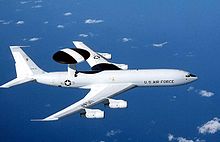
The purpose of electronic warfare is to deny the opponent an advantage in the EMS and ensure friendly, unimpeded access to the EM spectrum portion of the information environment. Electronic warfare aircraft are used to keep airspaces friendly, and send critical information to anyone who needs it. They are often called "The Eye in the Sky."
Fighters[change | change source]

The fighter aircraft of the USAF are small, fast, and maneuverable military aircraft primarily used for air-to-air combat. Many of these fighters have secondary ground-attack capabilities, and some are dual-roled as fighter-bombers (e.g., the F-16 Fighting Falcon); the term "fighter" is also sometimes used colloquially for dedicated ground-attack aircraft. Other missions include interception of bombers and other fighters, reconnaissance, and patrol. Out of the 5,778 manned aircraft in service, 2,402 are fighters, and 1,245 of those are variants of the F-16 Fighting Falcon.
Search and Rescue[change | change source]
These craft are used for search and rescue on land.
Tanker[change | change source]

The USAF's aerial refueling aircraft are deritives of civilian jets. Usually, the aircraft providing the fuel is specially designed for the task, although refueling pods can be fitted to existing aircraft designs if the "probe and drogue" system is to be used. There is no known regular civilian in-flight refueling activity. In large-scale operations (and even daily air operations), air-to-air refueling is extensively used; fighters, bombers, and cargo aircraft rely heavily on the lesser-known "tanker" aircraft. This makes these aircraft an essential part of the Air Force's global mobility and the U.S. force projection.
Multi-mission UAVs (Unmanned Aerial Vehicles)[change | change source]
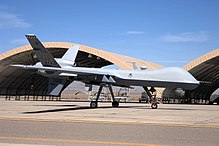
Initial generations of UAVs were primarily surveillance aircraft, but some were fitted with weaponry (such as the MQ-1 Predator, which utilized AGM-114 Hellfire air-to-ground missiles). An armed UAV is known as an unmanned combat air vehicle (UCAV). The near future will likely see unmanned aircraft employed, offensively, for bombing and ground attack. While air-to-air combat will likely remain the last domain of the human pilot, when unmanned fighter jets do come about, they will enjoy the advantage of almost unlimited immunity to G-force effects.
Observation[change | change source]
These aircraft are modified to observe (through visual or other means) and report tactical information concerning composition and disposition of forces.
Reconnaissance[change | change source]
The reconnaissance aircraft of the USAF are used for monitoring enemy activity, originally carrying no armament. Several unmanned remotely-controlled reconnaissance aircraft (UAVs) have been developed and deployed. Recently, the UAVs have been seen to offer the possibility of cheaper, more capable fighting machines that can be used without risk to aircrews.
Note: Although the U-2 is designated as a 'utility' aircraft, it is indeed a reconnaissance platform.
Trainer[change | change source]
The Air Force's trainer aircraft are used to train pilots, navigators, and other aircrew in their duties.
Utility[change | change source]
Utility aircraft are used basically for what they are needed for at the time. For example, a Huey may be used to transport personel around a large base or launch site, while it can also be used for evacuation. These aircraft are all around use aircraft.
VIP Transport[change | change source]
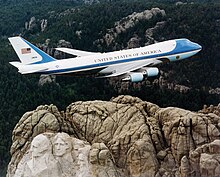
These aircraft are used for the transportation of Very Important Persons. Notable people include the President, Vice President, secretaries, government officials (e.g., senators and representatives), the Joint Chiefs of Staff, and other key personel.
Weather Reconnaissance[change | change source]
These aircraft are used to study meteorological events such as hurricanes and typhoons.
Foreign aircraft used by USAF[change | change source]
Culture[change | change source]
Slogans & Creeds[change | change source]
The United States Air Force has had numerous recruiting slogans including "No one Comes Close" and Uno Ab Alto. For many years, the U.S. Air Force used "Aim High" as its recruiting slogan; more recently, they have used "Cross Into the Blue", "We've been waiting for you" and "Do Something Amazing",[19] and the newest one, "Above All".[20] Each wing, group, or squadron usually has its own slogan(s). Information and logos can usually be found on the wing, group, or squadron websites.[21]
The Airman's Creed is a statement introduced in the spring of 2007 to summarize the culture of the Air Force.
Air Force Core Values: Integrity First, Service Before Self, Excellence In All We Do
To help further knowledge of their mission and functions, the Air Force has also produced videos, such as "Setting the Conditions for Victory" and "How We Fight",[22] to outline the Air Force role in the war on terrorism and how the service succeeds in its domains of air, space and cyberspace. The Above All campaign continues to support the message of "air, space and cyberspace" dominance.
See also[change | change source]
[[:wikisource:|]]
- Air Force Aeronautical Ratings
- Air Force Association
- Air Force Combat Ammunition Center
- Air Force Medical Service
- Air Force Knowledge Now
- Air Force Specialty Code
- Air National Guard
- Aviation Nation
- Civil Air Patrol
- Comparative military ranks
- JROTC
- List of air forces
- List of Famous Airmen
- List of military aircraft of the United States
- List of U.S. Air Force bases
- List of Wings of the United States Air Force
- National Museum of the United States Air Force
- Project Blue Book - USAF's UFO investigation (1947-1969)
- Ranks and Insignia of NATO
- AFROTC
- U.S. Air Force Band
- Strategic Air Command
- Tactical Air Command
- "The U.S. Air Force", the official song of the USAF
- United States Air Force Academy
- Enlisted commissioning
- U.S. Air Force Thunderbirds
- United States military aircraft serials
References[change | change source]
- ↑ 80 P.L. 235, 61 Stat. 495 (1947); Air Force Link, (2006) "Factsheets: The U.S. Air Force". Retrieved April 7, 2006.
- ↑ "2008 Air Force Almanac", AIR FORCE Magazine, May 2008, p.61.
- ↑ "Gallery of USAF Weapons, 2008 Air Force Almanac", AIR FORCE Magazine, May 2008, p. 155. USAF plans to retire all 460 AGM-129 in 2008, and all but 528 ALCM by 2012.
- ↑ "2008 Air Force Almanac", AIR FORCE Magazine, May 2008, p.48. The foreign hire figure is 6,617 persons.
- ↑ Air Force Link, (2008). [1]. Retrieved September 21, 2008.
- ↑ U.S. Intelligence Community (October 2004). National Security Act of 1947. Retrieved April 14, 2006.
- ↑ U.S. Department of State(2006). National Security Act of 1947. Retrieved April 14, 2006.
- ↑ 8.0 8.1 Needed: 200 New Aircraft a Year, Air Force Magazine, October 2008.
- ↑ "2008 USAF Almanac: People" (pdf). AIR FORCE Magazine.
{{cite web}}: Cite has empty unknown parameter:|coauthors=(help); Italic or bold markup not allowed in:|publisher=(help) 1991: 510,000; 2007: 328,600 - ↑ "Washington watch", AIR FORCE Magazine, July 2008, Vol. 91 No. 7, pp. 8.
- ↑ Chavanne, Bettina H. "USAF Creates Global Strike Command". Aviation Week, 24 October 2008.
- ↑ 12.0 12.1 "Air Force Pamphlet 36-2241". USAF, 1 July 2007.
- ↑ The primary source for the humanitarian operations of the USAF is the United States Air Force Supervisory Examination Study Guide (2005)
- ↑ "2007 USAF Almanac: Major Commands" (PDF). AIR FORCE Magazine. Retrieved 9 February 2008.
{{cite web}}: Cite has empty unknown parameter:|coauthors=(help); Italic or bold markup not allowed in:|publisher=(help) - ↑ "2007 USAF Almanac: USAF Squadrons By Mission Type" (PDF). AIR FORCE Magazine. Retrieved 9 February 2008.
{{cite web}}: Cite has empty unknown parameter:|coauthors=(help); Italic or bold markup not allowed in:|publisher=(help) - ↑ [2] Air Force Specialty Code Information, United States Air Force, July 2008.
- ↑ "Getting the Blues, by Tech. Sgt. Pat McKenna". Air Force Link. Retrieved 2007-09-24.
- ↑ Photos: Airtech CN-235 Aircraft Pictures | Airliners.net
- ↑ "Do Something Amazing" web site
- ↑ "Air Force rolls out new advertising campaign", Airforcetimes.com, March 2, 2008.
- ↑ US Air Force Mottos. Military-quotes.com, Retrieved 4 June 2006.
- ↑ "'Setting the Conditions for Victory' video premieres online", USAF, October 3, 2007
References to U.S. Army predecessors of today's U.S. Air Force are cited under their respective articles.
External links[change | change source]
- Official USAF website
- Official USAF Recruiting site
- DoSomethingAmazing.com Official USAF media-based recruiting site
- AirForceBlueTube
- Official blog: Air Force Live
- Searchable database of Air Force historical reports
- USAF emblems
- USAF Communications Troops
Template:US Air Force navbox Template:US military navbox
Category:Military units and formations established in 1947 United States Air Force Air Force Category:Air forces by country simple:United States Air Force
